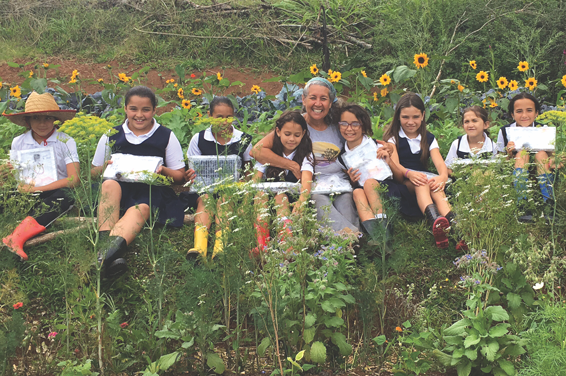
The strongest storm to make landfall in Puerto Rico in nearly a century, Hurricane Maria came ashore on September 20, 2017, and knocked out power to the entire island. The widespread devastation and lingering power outages triggered a creative response from the University.
During the spring semester, Science, Technology, Engineering, and Mathematics (STEM) students and faculty from St. John’s College of Liberal Arts and Sciences joined together for an Academic Service-Learning (AS-L) project to aid in Puerto Rico’s recovery. Together, they designed and built solar panels for children at a rural K–9 elementary school—Escuela Segunda Unidad Botijas #1—which had been operating with the use of generators since the catastrophic storm.
“We felt that we needed to do something for Puerto Rico,” said Alison Hyslop, Ph.D., Associate Professor and Chair, Department of Chemistry, who led the University’s efforts. Other faculty agreed, and along with Bryan W. Hall, Ph.D., Associate Dean, Undergraduate Division, St. John’s College of Liberal Arts and Sciences, they secured strategic priority funding from the University to pursue the interdisciplinary, faculty-driven STEM project. Dr. Hall then reached out to Lynn Stravino, Director of AS-L, and the Vincentian Institute for Social Action to collaborate.
“When Dr. Hall contacted me with the proposal, we were very excited about it,” Ms. Stravino said, adding, “The construction of the solar panels follows St. John’s Vincentian perspective and honors Pope Francis’s teaching regarding education ‘to find creative ways to help the poor.’”
The University supported the purchase of materials, and 80 St. John’s undergraduate students gathered in a laboratory in St. Albert Hall on April 16 to work together to create the solar panels. The panels can charge a cell phone or other devices connected to a USB cable within a few hours, allowing more than 200 students in the school to once again gain access to the Internet.
According to Ms. Stravino, the initial challenge was to find the right community partner. Louis E. Saavedra, a Coordinator in the AS-L office, contacted Nuestro Ideal, an organization that promotes and develops innovative ideas for the cultural, educational, and economic benefit of the people of Latin America and beyond.
“The school will be using these power cells as soon as possible,” said Luis Nicho, Executive Director of Nuestro Ideal. They were shipped by Mr. Nicho’s nonprofit organization and arrived in the students’ hands by mid-May.
Managed by Dr. Hyslop, the project included students taking University Calculus I with Florin Catrina, Ph.D.; Advanced General Chemistry II Recitation with Richard J. Rosso, Ph.D.; and Scientific Inquiry with Paula Kay Lazrus, Ph.D.; along with Society of Physics students led by Charles Fortmann, Ph.D. The University departments of Mathematics and Computer Science, Physics, Chemistry, and the Institute for Core Studies were also represented.
“It is great that AS-L is helping to popularize STEM,” said Dr. Catrina. Dr. Rosso agreed. “For the STEM students to take something they learned in class and apply it to the real world is really eye-opening. They are making a difference with science.”
Upon completion of the work, St. John’s students posted reflection videos and shared information with each other through Blackboard—a web-based tool that allows faculty to share resources with students. “The project was very admirable and demonstrated a great act of kindness that all universities should strive to achieve,” said David DeLuca, a sophomore Chemistry major who participated in the effort.
“Making these solar panels has helped us as students connect the topics we learn in the classroom with important issues around the world,” said sophomore and Chemistry major Spela Kunstelj. “This also helps us to see the importance of science in everyday life and how our education can be a tool to help others.” She added, “Personally, this experience has inspired me to continue using science to advocate for issues of social justice and for the environment.”
Related News
Leading with Heart: Lucy A. Pesce Recognized for Changing Lives at St. John’s
Commitment to the Vincentian mission shone brightly last week when Lucy A. Pesce, Executive Director for Mission Initiatives at St. John’s University, was honored by Depaul USA with the Dax Champion Award for her unwavering leadership and compassion. Ms. Pesce’s recognition highlights not only her personal dedication but also the University’s broader mission to uplift and serve individuals experiencing homelessness.
Vocation Festival Showcases Diversity of Opportunities in Religious Life
Eager to help young people discern a call to religious service, representatives of 13 Catholic congregations gathered in the D’Angelo Center plaza for St. John’s University’s fourth annual Vocation Festival.
Rev. Stephen Bicsko, C.M.: In Memoriam
With deep reverence and heartfelt sorrow, St. John’s University remembers the life and ministry of Rev. Stephen Charles Bicsko, C.M., a devoted Vincentian priest whose life was a testament to compassion, faith, and service to others.
